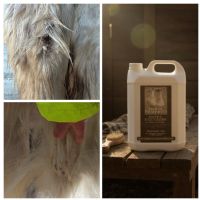
Gypsy Cobs Feather and DNA…
Gypsy Cobs are bred from some of our favourite native breeds native breeds including Fell Ponies, Welsh Cobs and heavy drafts horses.
It is in the Traditional Gypsy Vanners ‘DNA’ to grow hair on their legs, hock down, ‘feather’. Hair is made up from keratin, which is produced knee down in abundance; the feathering, starting from the knee. The heavier feathered a Gypsy Vanner, the more keratin they produce as a result of their genetic make up.
An overproduction of keratin, commonly produces a ‘thickening of skin’, in medical terms, hyperkeratosis. It is in the joints, at the back of the knee and in front of the hocks, where the thickened skin often becomes dry, cracked and can result in open and weeping sores, also known as Mallanders and Sallanders (M&S) which, left unattended can lead to infection and even lameness.
Feather Mites
M&S are an ideal environment for feather mites (Chorioptic Mite); the thickened skin a 5 star feast and the gooey, weeping wounds and ideal place to lay their eggs.
Once sore and possibly infected, joints can soon become irritated and extremely sore and sensitive, making it often difficult to tend to the legs with most methods and the cob in question, agitated and unpredictable. If left the mite infestation (Chorioptic Mange), can lead to CPL (Chronic Progressive Lymphedema).
Breaking the cycle and managing hyperkeratosis, mallanders and sallanders, feather mite infestation is the key to preventing further complications.
‘Oiling the feather’
Oiling has traditionally been used since the Gypsy Cob breed began and before in its native ancestral breeds i.e. the Fell Pony.
Engine oil was used back then, as it was one of the few oils readily available and affordable. Years later, cob owners adopted the method of pig farmers and began using Pig Oil (mineral oil). Oiling the thickened skin, particularly the joints, prevents breakage, keeping the skin supple and avoiding M&S aka Greasy Heel/Knee.
Feather mites will always be attracted to the warm feather to hide in and the skin debris to feast upon on a feathered horses legs, as in mites on poultry; however, can be prevented and keeping any cob mite free, far less complicates M&S breakouts.
Prevent, Manage and Control with our own unique formula:
Mitey Feathers Heavy Horse Leg Oil or Cream can be used to break the cycle 🔁
(Hyperkaratosis - Mallanders & Sallanders - Feather Mites).
A natural formula with vitamins Mitey Feathers contains several plant based ingredients to repel and control feather mite infestation whilst, at the same time moisturising the skin, nourishing and protecting the feather.
The active ingredient, whilst naturally derived, is recognised by the HSE* as an approved pesticide to control Chorioptic Mange, in the feather of heavy horse breeds.
*under the pesticides regulations act 1987.
Click here for more information about our unique formula for feather and leg care, a video guide on how to apply and directions of use...
Your name *